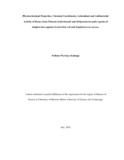| dc.description.abstract | Free radicals are natural byproducts of chemical processes, such as metabolism. They move through cells, disrupting the structure of other molecules and resulting in cellular damage. The damage coupled with pathogenic bacterial activity in the body is believed to contribute significantly to various health problems; macular degeneration, aging, bacterial diseases, cardiovascular problems, certain cancers, emphysema, Alzheimer’s and Parkinson’s diseases, ulcers and all inflammatory diseases, such as arthritis and lupus. Antioxidants protect key cell components from damage by neutralizing the free radicals. They occur naturally in the body or are consumed through the diet and hence help block cell damage. Honey particularly from the stingless bees is believed to be a source of antioxidants due its high pollen load and also possess antimicrobial compounds. It is good for scavenging free radicals, limiting microbes’ proliferation and hence has potential for management of health problems that result from the effect of free radicals generated by the body cell. So far, there is no reported study on stingless bee honey constituent(s), potential as an antioxidant; neither is there any report on its antibacterial activity in Kenya. The aim of this research was to determine the chemical constituents, the antioxidant and antibacterial activity of honey from Plebenia hylderbrandii and Meliponula bocandei species of stingless bees against selected bacterial species viz; Escherichia coli and Staphylococcus aureus. The organic compounds of the honey were extracted using column extraction method and elution of the organic compounds done using acetone. Analysis of the organic compounds was done by use of liquid chromatography Electrospray ionization Quadrupole Time of flight Mass spectrometry (LC-ESI-QTOF-MS). The antioxidant activity of the honey was determined using Ferric Reducing Antioxidant Power (FRAP) assay and 2, 2-diphenyl-1-picrylhydrazyl (DPPH) methods while the antibacterial activity was done by agar dilution method. Data obtained was analyzed statistically using Predictive Analytics SoftWare (PASW), Version 20. Thirty five (35) organic compounds including, O-glycosyl compounds, tricarboxylic acids and derivatives, isoquinoline derivatives, tannins, peptides and derivatives, flavonoids, terpene glycosides, coumarin derivatives, quinic acid derivatives, phenolic glycosides, anthracycline derivatives, porphyrins, pyridyl piperazine derivatives and indole derivatives were identified from the 2 honey samples. The honeys’ physicochemical properties (pH, electrical conductivity, color intensity, moisture content) obtained were compared with East African Standards (EAS), European Union (EU) and Codex Alimentarius honey standards (2001). The Inhibition Concentration, IC50 values for the DPPH % scavenging activity ranged between 10.61-14.31 mg/ml. The FRAP results ranged from 585.82 μM for Meliponula bocandei to 911.36 μM for Plebenia hylderbrandii honeys Fe (II) /100 ml of honey. In addition, both honey types exhibited antibacterial activity against both S. aureus and E. coli but Plebenia hyderbrandii honey had a higher antibacterial effect than Meliponula bocandei honey against the two bacteria at the tested concentrations. This study reports for the first time the antioxidant activity and chemical composition of Meliponula bocandei and Plebenia hylderbrandii stingless bee honey samples from Western Kenya. Thus, it is evident that the potential of honey as an antioxidant results from an extensive range of compounds such as glycosides, quinolines, amino acids, flavonoids, among others. These natural antioxidants could be better alternatives to most synthetic antioxidants most of which have a lot of negative health repercussions. In addition, the two stingless bee honey possess bacteriostatic and bactericidal activity in vitro. Therefore, the various medicinal usages may be related to the honeys’ chemical constituents, antioxidant and antibacterial activity. It is thus recommended that the honey harvested from the two stingless bees can be used as nutritional supplements in management of cancer, healing of wounds and inflammatory infections. | en_US |

